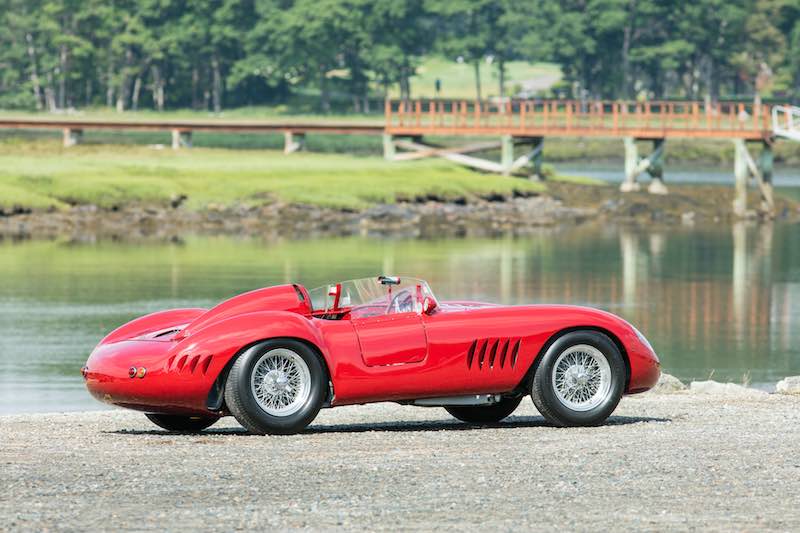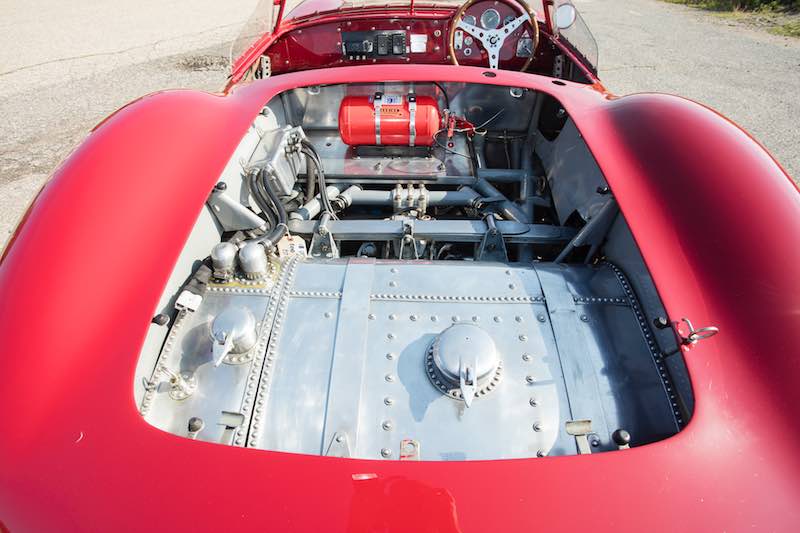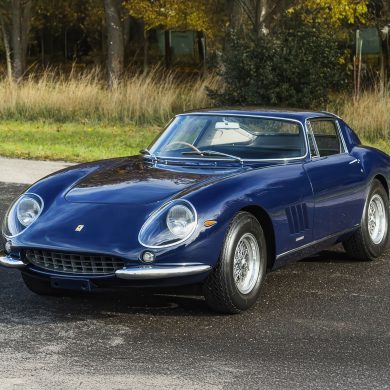The Maserati brothers of Bologna founded their racing car manufacturing company in 1926. The company was pure-bred, real racers building real racing cars for a racing-orientated specialist clientele. And so they remained for many years. After the Gruppo Orsi organization bought the company in 1937, and the brothers finally completed their service contracts and left in 1947-48 — founding OSCA — Maserati as a marque continued its dedication to competition, with a road car production line only slowly beginning to emerge.
Racing customers found Maserati generally more helpful than other manufacturers, more willing to do a deal with its racing customers, and its line of 2-liter A6GCS sports-racing cars earned many friends into the early 1950s. The 6 cylinder twin overhead camshaft engines were powerful within their class and the chassis developed by engineer Vittorio Bellentani — proved relatively light but good handling and nimble. Maserati in fact proved more effective within the smaller capacity classes, up to 2-liters, than their rivals and neighbours, Ferrari at Maranello.
But the Maserati management team visualized an entry in the larger capacity class of sports car competition, for in 1954-55 Vittorio Bellentani developed the 300S 3-liter 6-cylinder model — combining in effect the best attributes of the 2-liter A6GCS with those of the latest 2.5-liter Formula 1 Maserati 250F.
From 1955 to 1959 at least 26 Maserati 300S sports-racing cars would be manufactured, emerging in three broad variants, each one more effective than its predecessor. Maserati’s first prototype 2.5-liter sports car engine building towards the full 3-liter 300S delivered some 240bhp at 7,200rpm on one of the Modena company’s dyno test beds. Juan Manuel Fangio and Onofre Marimon co-drove the prototype upon its debut in the Supercortemaggiore Grand Prix at Monza Autodrome.
Of the first batch of five 300S cars to be constructed, three were destined for the American market — all ordered by Briggs Cunningham. The first three frames were considered too flexible and so modifications were made to numbers four and five. The definitive Maserati 300S sports-racing cars then emerged with what was rated by many world class drivers as being the best handling of all mid-1950s sports-racing cars.
From 1956 to 1958 the British superstar driver Stirling Moss started 13 races in Maserati 300S cars and he took them over in three further races having started in different models. From that total of 16 events, the Maserati 300S gave him nine race wins, three second places, a third and a fifth and only two retirements. Moss described the 300S as being “…strong and dependable, also quite like an Aston Martin DB3S in its general feel and responsiveness, but it was even better balanced and, in my experience, almost unburstable. Today, people rave about Ferrari’s fantastic reliability. True, they used to spread it wider across the board amongst all their customers, but a decently-prepared 300S had a chassis which was infinitely superior to any front-engined sports Ferrari and although it lacked their wonderfully smooth and powerful V12 engines, its 6 cylinder was always man enough for the job…”
Stirling Moss wrote in his diary after a particularly challenging Buenos Aires 1,000Kms race in Argentina in which he started in a 450 S Maserati but finished in a 300S when the 450S had mechanical failure: “It had been a wonderful race for me which I enjoyed enormously. This was my greatest drive. Car (300S) fabulous — 6,400rpm and I braked at 250 metres, in 450S braking at 500 metres.” This is a most personal testimonial from one of the greatest drivers of all time which absolutely underlines the fabulous Maserati 300S’s stature within racing at that time, and within the Historic and Vintage scene today.
Maserati 300 S, chassis 3069
If the Maserati 300S was one of Moss’s favorites to drive, he is also on record as having described Fangio as the greatest of them all, and this remarkable 60 year old sports racing car brings together all of those characteristics and this mythical driver.
Historian Walter Baumer is an acknowledged expert on Maserati sports racing cars, and penned the definitive reference work on the model in 2008. That Maserati book is being updated and Bonhams consulted with Mr. Baumer in advance of the new updated publication in an effort to chart the history of 3069 in its most up to date form. Mr. Baumer feels that it is highly likely that 3069 was a factory works car in 1956, but it has not been possible for him to chart specific results as a result of famously poor record keeping at Maserati at races, nor with its first privateer owner, Italian Armando Zampiero, who bought the car from Maserati in 1957. However the sale of the car in 1957 brought the greatest driver of all time into the cockpit of 3069.
The car was upgraded by the factory to the latest and most up to date specifications for the 1957 race season and the factory sold 3069 to Marciello Giambertone, for the use by the legendary racing driver Juan Manuel Fangio. For the 1957 season, Fangio joined the Maserati team for Formula 1, and famously would pilot their 250F Single Seaters, but he was not contracted for the factory for sports racing cars and raced for private teams.
In 1957, chassis 3069 won its first documented race at the Mansanto race track in Portugal being driven by Juan Fangio, and entered under Giambertone’s Scuderina Madunina. Faced with some formidable competition including Masten Gregory in a Ferrari 290MM, Fangio not only won the race he took fastest lap.
By the fall, Giambertone exported this Maserati to South America, where it would be used again by Fangio. On successive weekends at Sao Paolo and Interlagos in dual heats, the team of Fangio and 3069 proved undefeatable — despite a one minute penalty for jumping the start of the second heat. Not surprisingly, the locals loved the sight of their home driver winning on his own continent and the event itself generated some $751,000 of income, a vast amount of money for its time. The win was good for Maserati too.
It is likely that its original engine which today resides in chassis 3062, a 300S also then owned and shipped to Brazil by Giambertone was switched in this period of its life. At this point the team parted with the car and it would begin a series of ownerships by wealthy South American privateers. Fangio’s wins in 3069 had drawn the attention of Brazilian playboy Severino Gomez-Silva who acquired it from Giambertone, he was famously proud of owning ‘Fangio’s car’ in addition to the 200S he already owned (2408). Industrialist and racing Privateer Henrique Casini exercised it at the inaugural Barra da Tijuca race in September 1958, where he again showed its prowess and won. Fernando Barreto was the next to saddle up, running it at the Triangular Tournament in Interlagos and 1000km of Buenos Aires among other races.
Amazingly, its career would continue throughout the 1960s and into the 1970s, giving it one of the longest careers of all 300S Maseratis. The car’s long racing life saw its body reconfigured a number of times, latterly resembling a 330TRI.
In the 1970s the car came to the attention of noted car historian and restorer Colin Crabbe. He was well known for car forays into the Southern Hemisphere and he retrieved numerous important racers. Crabbe acquired the car in August 12, 1978 from a Brazilian named Adolfo Netto for $13,700. The Brazilian export documents and the UK import documents describe a car chassis 3069, less bodywork skin but with original chassis, body hoops and frames, engine, gearbox and wheels. By 1983 it was fully restored and would pass through the hands of a series of noted UK and European racers.
Ultimately, it would arrive in the stable of Michel Seydoux. From Seydoux the car was sold publicly at auction to noted racer Lord Laidlaw in the UK.
The present owner, who is an excellent driver in his own right and a two time class winner of the 24 Hours of Le Mans, acquired 3069 in 1998. He used it extensively in historic racing and particularly to compete in the Ferrari/Maserati Shell Historic Challenge, which from the late 1990s allowed Maseratis to race alongside Ferraris. In this race car the current owner acquired the perfect vehicle to compete at the highest level and 3069 became a regular sight on many of the grids of European historic races in this period. Over the course of the next 10 years, the Maserati won and competed in a great many races and enjoyed another wonderful chapter in its racing career, including being raced at the Le Mans Classic, winning numerous Ferrari/Maserati historic races as well as being raced at Goodwood, Laguna Seca, Monza, Silverstone, Pau, Nuremburg as well as campaigned in numerous Mille Miglias.
It was restored by the current owner at DL George & Son in Pennsylvania and the engine was rebuilt by the engine builder Paul Lanzante in England.
Recently, the car’s use has been more limited, leading to the decision after some 19 years of ownership to part with it. 3069 is presently refitted with Maserati original engine 3058, numero interno 31, which has been with the car for probably 50 years at least, which according to Baumer was the first engine fitted to Parravano’s 3058 car, prior to the factory supplying a spare, which is also correct and resides in 3058 today.
One of the great definitive sports racing cars of all time, a 300S offers eligibility to almost every major retrospective historic event, including the desired tickets of circuit meetings including Goodwood Revival, endurance events such as the Le Mans Classic, and of course, the Mille Miglia, thereby enabling it for spinoffs such as the Colorado Grand. 3069 presents a fabulous opportunity to compete and to be competitive as proven by an active racing career for almost all of its life.
—
This 1956 Maserati 300S will be offered at the Bonhams Quail Lodge sale, scheduled for August 18, 2017 in California during Monterey Classic Car Week. It’s estimated to sell for $6,000,000 to $7,000,000.
- Ex-Juan Manuel Fangio
- 1957 Grand Prix of Portugal and Brazil Winner
- Present Ownership Since 1998
[Source: Bonhams; photos: Pawel Litwinski]























